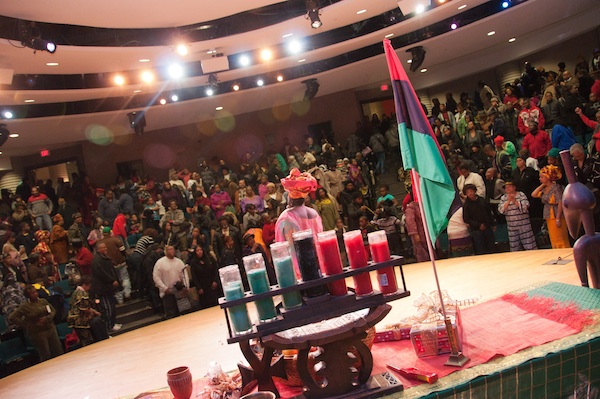
A Gap in Kwanzaa
By Gregory Lucas-Myers, Charles H. Wright Museum of African American History
From December 26 to December 29, 2011, the Charles H. Wright Museum of African-American History held nightly Kwanzaa Celebrations, each event punctuated by a variety of activities and attractions. On the final evening, a fashion show graced the stage, featuring a pair of Detroit designers. Museum intern Gregory Lucas-Myers takes inspiration from that show to highlight the holiday.
Born out of the Black Power movement, Kwanzaa was first officially celebrated in 1966. One year earlier, Dr. Charles Wright and others established the International Afro-American Museum. Now, 45 years later, I find myself watching from the sound booth as the world’s foremost institution on chronicling African-American history put on the last event of its annual Kwanzaa observance. Each of the four evenings of festivities corresponded to one of seven principles, ideas or values that serve as foundations for the betterment of African and African-American life and culture. For Thursday, December 29, the principle was Ujamaa, or co-operative economics, defined as “To build and maintain our own stores, shops, and other businesses, and to profit from them together.”
In centering its final night of annual Kwanzaa celebration on the idea of co-operative economics, The Wright Museum capped off the night of libations and affirmations with a fashion show, the designers hailing from metro Detroit. As the models showed off their clothes on-stage, I took notice of a developing contrast. From one designer, there were clothes one expected at an Afro-centric showcase. Loose linen shirts, slacks, and wraps draped the models’ bodies in vibrant greens, deep blues, and other colors, and the overall aesthetic was kept simple. From the other fashion line, modern style and glamour held sway, as the models strutted in jeans, fancy boots, dramatic patterns, and even a white, shag shawl.
An episode of thematic reinforcement took place as a colleague and I manned the sound booth. We were given two CDs with which to work; the first containing classic Motown and the second, a mix of contemporary R&B and soul songs. A little while later, an audience member was passing by our station. She was an older woman, her personal fashion influenced by traditional African attire. Earlier in the program, when audience members were called on to share “the greatest gift they ever gave someone” in the spirit of community and charity, she stated that the way she dressed was her gift, in that she hoped to inspire passers-by to think of the culture’s past grandness and take pride in it.
So, here we were playing Motown and contemporary R&B for the fashion show, and noticing the lack of Pan-African music. When the audience member peeked in, she also, though light-heartedly, wondered if we had more appropriate music. The idea of a generational incompatibility was cemented. Until recently, I didn’t know what to make of this cultural gap. Kwanzaa was crafted to correspond closely with traditional African times of harvest, steeped in items symbolic of returning to our roots (the famous candle holder, called a kinara, is symbolic of such). Would closer-to-contemporary-but-still-“old school” influences like Motown not have a place during Kwanzaa? Did we have to wholly shun present day representations of our culture, things that, sometimes unfairly, may be associated with negative aspects and challenges we face?
I found my answer in another principle of Kwanzaa. Umoja, or unity, is defined as “To strive for and maintain unity in the family, community, nation, and race.” All of our collective experience, from Africa to the battles being fought today, helped to inspire every piece of art, music, and even fashion in our culture. In this way, all these pieces are symbols of our people and Kwanzaa. Modern fashion and music will never supplant the traditional icons of the holiday, but perhaps pleasantly expand its scope.
Recent Content
-
Artsarticle ·
-
Artsarticle ·
-
Artsarticle ·

